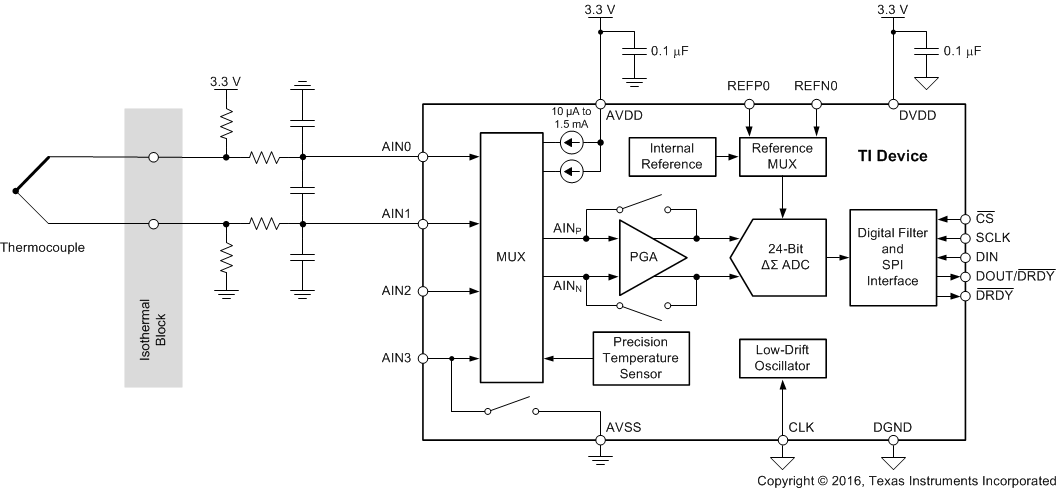SBAS501C May 2013 – August 2016 ADS1220
PRODUCTION DATA.
- 1 Features
- 2 Applications
- 3 Description
- 4 Revision History
- 5 Pin Configuration and Functions
- 6 Specifications
- 7 Parameter Measurement Information
-
8 Detailed Description
- 8.1 Overview
- 8.2 Functional Block Diagram
- 8.3 Feature Description
- 8.4 Device Functional Modes
- 8.5 Programming
- 8.6 Register Map
- 9 Application and Implementation
- 10Power Supply Recommendations
- 11Layout
- 12Device and Documentation Support
- 13Mechanical, Packaging, and Orderable Information
パッケージ・オプション
メカニカル・データ(パッケージ|ピン)
サーマルパッド・メカニカル・データ
- RVA|16
発注情報
1 Features
- Low Current Consumption:
As Low as 120 μA (typ) in Duty-Cycle Mode - Wide Supply Range: 2.3 V to 5.5 V
- Programmable Gain: 1 V/V to 128 V/V
- Programmable Data Rates: Up to 2 kSPS
- Up to 20-Bits Effective Resolution
- Simultaneous 50-Hz and 60-Hz Rejection at
20 SPS with Single-Cycle Settling Digital Filter - Two Differential or Four Single-Ended Inputs
- Dual Matched Programmable Current Sources:
10 μA to 1.5 mA - Internal 2.048-V Reference: 5 ppm/°C (typ) Drift
- Internal 2% Accurate Oscillator
- Internal Temperature Sensor:
0.5°C (typ) Accuracy - SPI-Compatible Interface (Mode 1)
- Package: 3.5-mm × 3.5-mm × 0.9-mm VQFN
2 Applications
- Temperature Sensor Measurements:
- Thermistors
- Thermocouples
- Resistance Temperature Detectors (RTDs):
2-, 3-, or 4-Wire Types
- Resistive Bridge Sensor Measurements:
- Pressure Sensors
- Strain Gauges
- Weigh Scales
- Portable Instrumentation
- Factory Automation and Process Control
3 Description
The ADS1220 is a precision, 24-bit, analog-to-digital converter (ADC) that offers many integrated features to reduce system cost and component count in applications measuring small sensor signals. The device features two differential or four single-ended inputs through a flexible input multiplexer (MUX), a low-noise, programmable gain amplifier (PGA), two programmable excitation current sources, a voltage reference, an oscillator, a low-side switch, and a precision temperature sensor.
The device can perform conversions at data rates up to 2000 samples-per-second (SPS) with single-cycle settling. At 20 SPS, the digital filter offers simultaneous 50-Hz and 60-Hz rejection for noisy industrial applications. The internal PGA offers gains up to 128 V/V. This PGA makes the ADS1220 ideally-suited for applications measuring small sensor signals, such as resistance temperature detectors (RTDs), thermocouples, thermistors, and resistive bridge sensors. The device supports measurements of pseudo- or fully-differential signals when using the PGA. Alternatively, the device can be configured to bypass the internal PGA while still providing high input impedance and gains up to 4 V/V, allowing for single-ended measurements.
Power consumption is as low as 120 µA when operating in duty-cycle mode with the PGA disabled. The ADS1220 is offered in a leadless VQFN-16 or a TSSOP-16 package and is specified over a temperature range of –40°C to +125°C.
Device Information(1)
| PART NUMBER | PACKAGE | BODY SIZE (NOM) |
|---|---|---|
| ADS1220 | VQFN (16) | 3.50 mm × 3.50 mm |
| TSSOP (16) | 5.00 mm × 4.40 mm |
- For all available packages, see the orderable addendum at the end of the data sheet.
